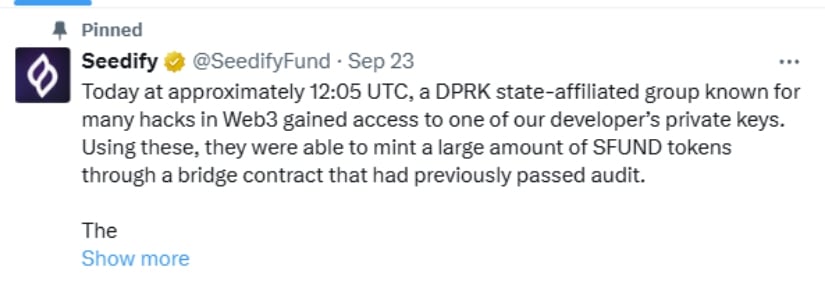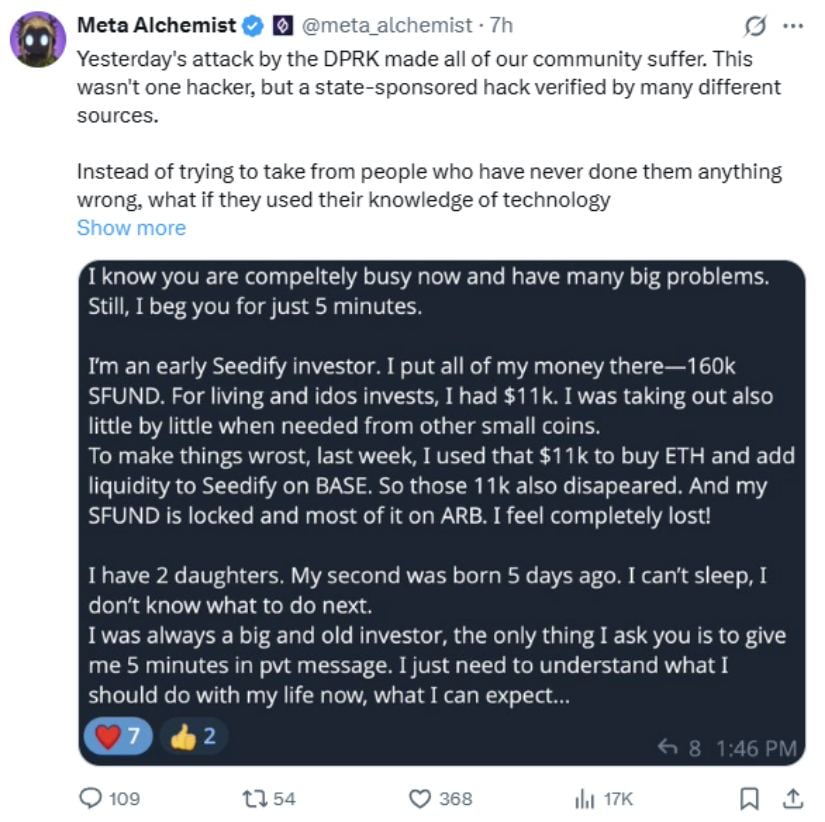In the never-boring realm of cryptocurrency – where fortunes are made, lost, and improbably recovered in the blink of an eye – the saga took a decidedly darkly comic turn on September 23, 2025. North Korean hackers, who clearly had nothing better to do, targeted Seedify’s cross-chain bridge like a ravenous digital raccoon, scooping $1.2 million into their virtual goody bag and reducing the SFUND token’s value to something approximating the price of a polite cough.
The Attack Unfolds (Or How to Steal a Digital Piggy Bank Without Breaking a Sweat)
Precisely at 12:05 UTC, hackers associated with North Korea’s “Contagious Interview” group-aptly named because their exploits spread faster than gossip at a wizard’s convention-gained access to a Seedify developer’s private keys. With this golden ticket in hand, they exploited an Achilles heel in the platform’s cross-chain bridge contract on Avalanche, conjuring up a torrent of unauthorized SFUND tokens as if by dark magic.

Like money launderers at a crypto carnival, the culprits frolicked across Ethereum, Arbitrum, and Base networks before converting most of their loot on BNB Chain. This orchestra of chaos drained liquidity pools and simultaneously sent the token value plummeting faster than you can say “decentralized finance.”
Seedify’s founder, Levent Cem Aydan-better known in the shadows as Meta Alchemist-vented his frustrations on social media: “DPRK/Lazarus decided to take everything we built over 4.5 years in one hack.” It’s heartbreakingly quaint that the bridge contracts had passed security audits, which now seem about as useful as a chocolate teapot in these circumstances.
Token Price Collapses (Or SFUND’s Sudden Descent into Worthlessness)
If crypto crashes were a sport, SFUND would’ve just won gold, plunging from $0.43 to “Why bother?” inside minutes-a breathtaking 99.99% crash. Investors, faced with the digital equivalent of watching their money vaporize, hit the panic button with a vigor normally reserved for emergency chocolate runs.
One particularly unlucky soul, known as @0xAbhiP, publicly mourned his six-figure investment now worth whatever the blockchain equivalent of lint is. Thousands of other SFUND holders echoed that pain-an impressive symphony of financial despair.
After some frantic damage control, SFUND clawed back to $0.21 and then $0.28, which is like finding a slightly damp penny after throwing your wallet out a window. Not great, but better than the abyss. This is a crushing fall from the $2.34 peak just a month earlier, proving once again that crypto markets have the emotional stability of a caffeinated squirrel.
Blame Game: When Fancy Forensics Point to North Korean Villains
Blockchain sleuth ZachXBT, wielding the forensic tools of digital wizardry, quickly fingered the perpetrators, connecting this mess to North Korea’s “Contagious Interview” crew. This gang is apparently responsible for over 230 similar misadventures this year alone-because why stop at one insult to your portfolio?

This revelation is notable because it’s not the headliners like Lazarus Group stealing the limelight, but another nefarious gang looking to make a splash. Security experts suggest that this means North Korea’s cybercrime league is expanding faster than goblins at a shopping spree and becoming increasingly audacious.
2024 and 2025 have seen these hackers go full “Mission: Impossible” on crypto, with losses attributed to them topping $1.3 billion. Their methods? Oh, just your run-of-the-mill espionage involving fake resumes, fraudulent interviews, and bribing employees-because when in doubt, why not add a little drama?
Industry Response and Recovery (Sort of Like Herding Digital Cats)
Seedify scrambled faster than a caffeine-fueled wizard to limit the damage, teaming up with major exchanges to freeze trading of SFUND and blacklist the hacker wallets across multiple blockchains. All cross-chain bridges were temporarily disabled, which is a bit like closing all the roads after a bank heist-better late than never.
Binance’s very own Changpeng Zhao (who probably has a more dramatic nickname somewhere) confirmed that about $200,000 was frozen at the HTX exchange, though the majority of the stolen loot continues to frolic freely across blockchain networks. Exchanges are now actively blacklisting those addresses, which is the crypto equivalent of public shaming but with more zeroes.
Meta Alchemist sweetened the pot, offering a bounty to ZachXBT to hunt down the culprits and recover the stolen fortune-because sometimes justice is best served with a side of blockchain bounty hunting. This partnership underscores how the crypto world increasingly relies on experts who speak fluent “digital detective.”
The entire crypto industry is watching, grim-faced and possibly clutching their security tokens tighter. Crypto hacks in 2024 have already drained $2.2 billion, with North Korean actors leading the leaderboard in mischief and mayhem. This latest debacle is the bitter cherry on that disastrous sundae, spotlighting glaring weaknesses in cross-chain bridge security.
Security Implications for DeFi (Or Why Bridges Are Like Those Sketchy Trolls Underneath)
The Seedify hack revealed that even bridges that have passed all the official “yes, we checked” security audits can harbor bugs bad enough to let unauthorized tokens rain down like a plague of budget confetti. Suddenly, the question isn’t “Can we trust audits?” but “Who’s auditing the auditors?”
Cross-chain bridges are juicy targets because, much like an unattended cookie jar, they hold vast amounts of crypto and contain complex code that’s about as transparent as a troll’s intentions. This incident falls into a well-worn pattern where billions evaporate into the ether thanks to these tricky digital architectural features.
Security gurus advise multi-signature controls, eagle-eyed on-chain activity monitoring, and readiness to respond to incidents-because in crypto, being prepared is the only thing between you and digital indigestion. The rush to launch shiny new DeFi toys often sidelines these precautions, leaving playgrounds ripe for the picking.
Meanwhile, North Korean hackers, clearly taking notes from the dark arts, have shifted tactics from blunt exchange hacks to exploiting the more delicate machinery of DeFi and cross-chain infrastructure. It’s a reminder that the bad guys evolve faster than a caffeinated chameleon.
The Road Ahead (Or How to Put the Pieces Back Together Without Losing Your Mind)
Seedify assures us that the core contracts, user wallets, and the essential protocol remain untouched-like a wizard’s favorite hat saved from a fire. However, the bridge exploit has shaken investor faith to its core, and rebuilding that trust will be as tricky as convincing a cat to take a bath.
The platform soldiers on, launching Web3 incubators and fairy-tale inspired launchpad services while trying desperately to patch the rift left by this monetary maelstrom. Sadly, the sharp drop in token price will probably haunt them like a ghost at a discotheque, impacting future partnerships and investments for a good long while.
Read More
- Robert Kirkman Launching Transformers, G.I. Joe Animated Universe With Adult ‘Energon’ Series
- Avantor’s Chairman Buys $1M Stake: A Dividend Hunter’s Dilemma?
- NextEra Energy: Powering Portfolios, Defying Odds
- EUR TRY PREDICTION
- AI Stock Insights: A Cautionary Tale of Investment in Uncertain Times
- Hedge Fund Magnate Bets on Future Giants While Insuring Against Semiconductor Woes
- Ex-Employee Mines Crypto Like a Digital Leprechaun! 😂💻💸
- UnitedHealth’s Fall: A Seasoned Investor’s Lament
- The Illusion of Zoom’s Ascent
- Oklo’s Stock Surge: A Skeptic’s Guide to Nuclear Hype
2025-09-25 01:45